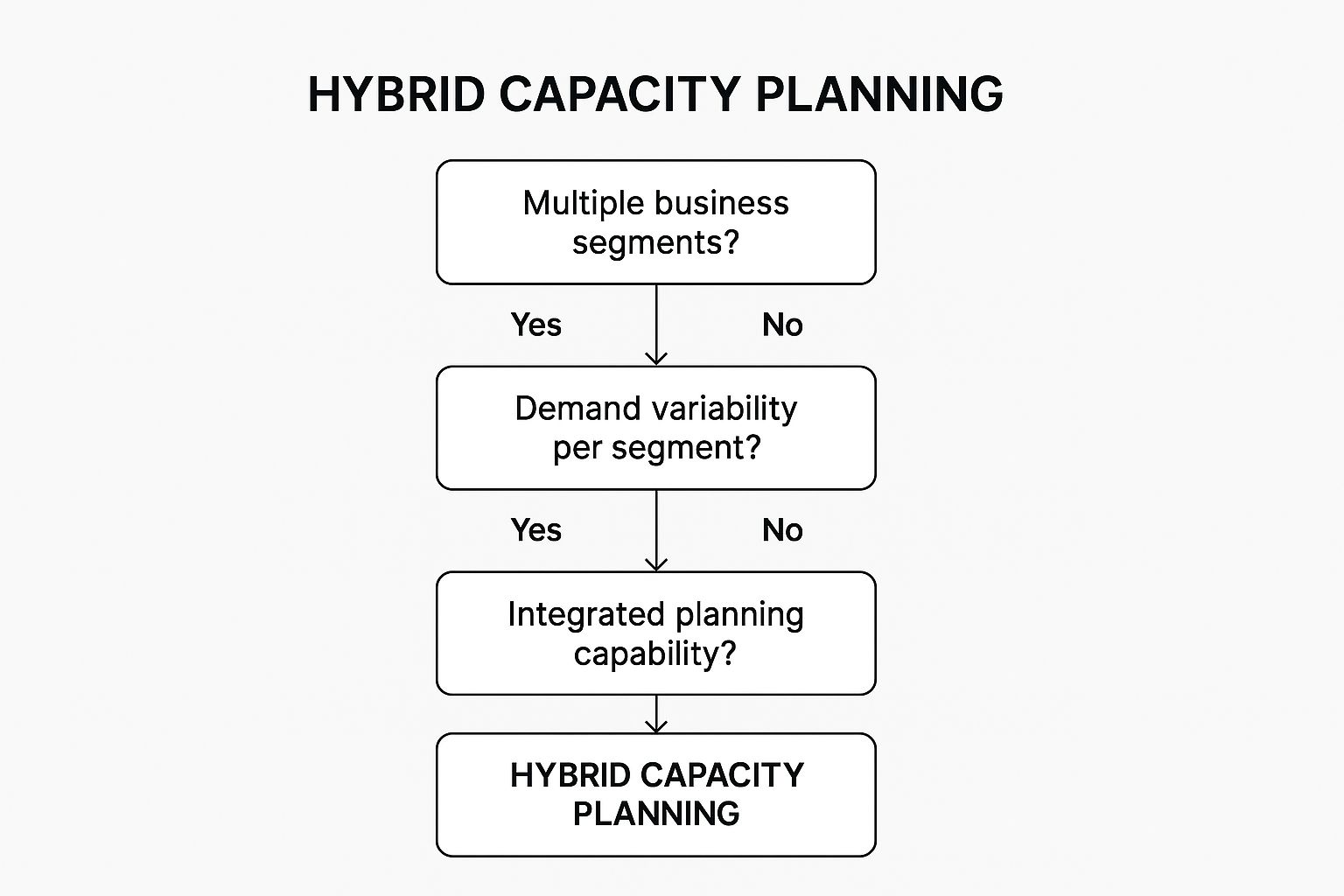For small and medium creative businesses, the line between 'productively busy' and 'chaotically overwhelmed' is razor-thin. One new client can tip the scales, leading to burnout, missed deadlines, and compromised quality. The solution isn't just working harder; it's working smarter. This is where capacity planning comes in. It's the art and science of matching your team's available time and skills (your capacity) with the work you have and the work you want (the demand).
Without a solid plan, you're essentially flying blind, risking either turning away profitable projects due to understaffing or paying for idle talent during slow periods. Effective capacity planning strategies transform this guesswork into a strategic advantage, allowing you to confidently pursue growth, maintain creative quality, and build a sustainable business. For creative agencies, design studios, and animation houses, mastering this is non-negotiable for long-term success. To truly understand how to optimize your workforce and drive business success, consider delving into staff capacity planning strategies to gain deeper insights into resource allocation.
This guide moves beyond theory to provide a practical toolkit. We will explore seven distinct strategies, from proactive growth models to reactive, demand-driven approaches. You will learn actionable steps to help you choose and implement the right method for your unique creative workflow, ensuring your team is always positioned for success.
1. Lead Strategy
The Lead Strategy is a proactive approach to capacity planning where a business increases its resources before an anticipated rise in demand. Rather than reacting to growth, you build the infrastructure to accommodate it ahead of time. This forward-thinking method ensures your creative agency or small business is always ready to seize new opportunities without scrambling, preventing service degradation or missed revenue.
This strategy is particularly effective for businesses expecting a significant, predictable surge in work. For example, a design agency that just won a major, long-term contract or a content firm preparing for a large-scale product launch for a client would benefit from adding capacity preemptively. It’s about building the runway before the plane needs to land.

When to Use the Lead Strategy
The Lead Strategy is ideal when the cost of unmet demand is high. If turning away a new client or failing to deliver on a project would damage your reputation and long-term prospects, having excess capacity is a worthwhile investment. It’s also suitable for businesses in high-growth markets where capturing market share quickly is a key competitive advantage.
How to Implement the Lead Strategy
Successfully executing this capacity planning strategy requires careful forecasting and a phased approach.
- Conservative Forecasting: Base your capacity additions on conservative growth projections. It's better to have a slight surplus than a significant, costly overbuild. Integrate these projections with your financial planning; aligning your capacity with your spending is crucial for sustainable growth. For more insights, you can explore detailed guides on how to align your marketing budget with growth forecasts.
- Phased Rollouts: Instead of a massive one-time expansion, add capacity in manageable stages. For a marketing agency, this could mean hiring one new designer this quarter and planning for another in six months, rather than hiring both at once.
- Modular Expansion: Adopt tools and processes that scale easily. This could involve using project management software that allows you to add users as needed or working with freelancers you can bring onto projects as demand increases, providing a flexible buffer.
- Monitor Utilization: Keep a close watch on your resource utilization rates. If your team's billable hours are consistently maxed out, it’s a clear signal that it’s time to enact the next phase of your expansion plan.
Key Insight: The Lead Strategy transforms capacity from a reactive constraint into a strategic asset. By staying ahead of demand, you ensure your business is perceived as reliable, scalable, and always prepared for the next big opportunity.
2. Lag Strategy
The Lag Strategy is a conservative, reactive approach to capacity planning where a business increases its resources only after demand has demonstrably increased. Instead of anticipating future needs, you wait for growth to materialize before investing in additional capacity. This method prioritizes financial prudence and minimizes the risk of overspending on underutilized assets.
This strategy is well-suited for businesses operating with tight budgets or in unpredictable markets. For instance, a small software company might only upgrade its servers after a sustained increase in active users, or a boutique marketing agency would hire a new specialist only after client work consistently exceeds the current team's bandwidth. It's about letting proven demand pull your capacity forward, rather than pushing capacity in front of potential demand.
When to Use the Lag Strategy
The Lag Strategy is most effective when the cost of carrying excess capacity is higher than the cost of occasional unmet demand. If your business can tolerate short-term bottlenecks and your clients are understanding of slight delays, this risk-averse approach protects your cash flow. It is ideal for startups and small businesses that need to validate their market before committing to significant expansion.
How to Implement the Lag Strategy
Successfully using this capacity planning strategy hinges on agility and clear communication.
- Monitor Key Metrics: Closely track leading demand indicators. For a creative agency, this could be the number of qualified leads in your pipeline, an increase in project scope requests, or consistent team overtime. Establish clear thresholds that trigger an expansion.
- Develop Rapid Deployment: Create a plan to add resources quickly when needed. This could involve maintaining a shortlist of vetted freelancers, having pre-configured software setups ready to deploy, or establishing relationships with temp agencies.
- Maintain Supplier Relationships: Build strong connections with flexible suppliers and contractors. Having these partners on standby allows you to scale your output rapidly without the overhead of permanent hires.
- Manage Client Expectations: Be transparent with clients about potential timelines if you are nearing full capacity. Proactive communication can prevent dissatisfaction and help manage project scope. For more on this, see these tips for managing project scope creep to keep deliverables on track.
Key Insight: The Lag Strategy aligns spending directly with revenue, making it a financially secure path to growth. By ensuring every investment is justified by existing demand, you build a lean, efficient, and resilient business.
3. Match Strategy
The Match Strategy is a balanced and responsive approach to capacity planning, aiming to synchronize your resources almost perfectly with fluctuating demand. Instead of building for a future guess or constantly playing catch-up, this method involves making smaller, incremental adjustments to capacity as demand trends become clear. It is the art of adding resources just as they are needed.
This strategy is a middle ground between the proactive Lead Strategy and the reactive Lag Strategy. For a creative agency, this could mean bringing on a freelance video editor for a specific three-month project or upgrading a software subscription to a higher tier during a busy quarter, then scaling back down. It’s about maintaining equilibrium and avoiding the costs of both significant overcapacity and damaging undercapacity.
When to Use the Match Strategy
The Match Strategy is most effective for businesses operating in markets with predictable fluctuations or clear, data-driven trends. If your demand has seasonal peaks, like a web design agency that gets busy before the holiday shopping season, this approach allows you to scale up efficiently for that period and then scale back down. It is ideal when you have access to reliable data and the flexibility to adjust resources relatively quickly.
How to Implement the Match Strategy
Executing the Match Strategy requires agility and a deep reliance on data to make timely adjustments.
- Invest in Forecasting Tools: Your ability to match demand hinges on your ability to predict it. Use project management software with reporting features or dedicated forecasting tools to analyze historical data and identify recurring patterns in your project pipeline.
- Develop Flexible Resource Pools: Don't rely solely on full-time hires. Build a strong network of trusted freelancers, contractors, and partner agencies. This allows you to quickly add specialized skills or extra hands for a specific project or a busy period without the long-term commitment of a new salary.
- Implement Real-Time Monitoring: Keep a close eye on key performance indicators (KPIs) like team utilization rates, project backlogs, and lead conversion rates. Set thresholds that trigger an action. For example, if your design team's utilization exceeds 85% for two consecutive weeks, it could be the trigger to engage a freelance designer.
- Create Feedback Loops: Regularly review your forecasting accuracy and the effectiveness of your capacity adjustments. Did you scale up too soon or too late? Use these insights to refine your triggers and improve your forecasting models for the next cycle.
Key Insight: The Match Strategy minimizes financial risk by preventing wasteful overspending on unused capacity while ensuring you are nimble enough to capture demand as it arises. It turns capacity planning into a dynamic, data-informed process rather than a static, long-term bet.
4. Dynamic Capacity Planning
Dynamic Capacity Planning is an agile, tech-driven approach that adjusts resources in real time based on current demand fluctuations. Rather than relying on long-term forecasts, this strategy uses automation and scalable infrastructure to continuously align capacity with immediate needs. For creative businesses, this means being able to instantly scale up for a viral campaign or scale down during a quiet period, optimizing costs and performance.
This strategy is epitomized by modern cloud computing platforms. Think of an e-commerce site scaling its servers during a flash sale or a streaming service like Netflix adding capacity to handle primetime viewing surges. It’s about creating a system that breathes with your demand, expanding and contracting automatically.

When to Use Dynamic Capacity Planning
This approach is best suited for businesses with highly volatile or unpredictable demand. If your workload can spike unexpectedly due to market trends, social media virality, or seasonal promotions, a dynamic model prevents service disruptions without the cost of permanent overcapacity. It’s ideal for digital-first agencies, SaaS companies, and any business leveraging cloud-based tools.
How to Implement Dynamic Capacity Planning
Success with this strategy hinges on technology and clear operational rules. It is a cornerstone of efficient creative operations management in a fast-paced digital environment.
- Implement Monitoring Systems: Deploy comprehensive tools to track key performance indicators (KPIs) like website traffic, project requests, or application response times in real-time. This data will trigger your scaling actions.
- Set Clear Scaling Rules: Define specific thresholds for scaling up and down. For example, automatically add a freelance designer to a project queue when active tasks exceed 15 per team member, or spin up a new server when CPU usage hits 80%.
- Test Scaling Mechanisms: Regularly test your automated scaling processes to ensure they work as expected. Run drills or simulations of high-demand scenarios to identify and fix any bottlenecks before they impact real clients.
- Maintain Manual Overrides: While automation is key, always retain the ability to manually intervene. This ensures you can respond to unique situations that your automated rules may not account for.
Key Insight: Dynamic Capacity Planning treats capacity not as a fixed number but as an elastic resource. By leveraging automation, you create a resilient, cost-efficient operation that can gracefully handle unpredictability and capture every opportunity.
5. Level Capacity Planning
Level Capacity Planning is a strategy centered on stability, where a business maintains a consistent level of resources regardless of demand fluctuations. Instead of scaling up or down, you keep your team size, infrastructure, and output constant. This approach smooths out operational peaks and valleys, using backlogs, service queues, or inventory to manage variations in customer demand.
This method is highly effective for businesses that prioritize predictability and operational efficiency over chasing every spike in demand. For example, a creative agency might maintain a steady, experienced team and manage its project pipeline through a waiting list. This ensures consistent quality and avoids the chaos of rapid hiring and firing, fostering a stable work environment.
When to Use Level Capacity Planning
The Level Capacity strategy is ideal when the costs of changing capacity are high or when maintaining a consistent, high-quality service standard is paramount. If hiring, training, and then laying off skilled creative professionals would be disruptive and expensive, a level approach is more sustainable. It's also well-suited for businesses with a strong reputation where clients are willing to wait for premium service.
How to Implement Level Capacity Planning
Successfully implementing this one of the most stable capacity planning strategies requires a focus on efficiency and managing client expectations.
- Develop Efficient Queue Management: Create a transparent and organized system for managing your project backlog or client waiting list. Communicate lead times clearly and provide regular updates to maintain client trust and satisfaction.
- Cross-Train Employees: With a fixed team size, flexibility is crucial. Cross-train your employees in multiple skills so they can shift between different tasks or roles as the nature of incoming projects changes, maximizing internal resource utilization.
- Build a Strategic Backlog: Use periods of lower demand to work on internal projects, process improvements, or professional development. This keeps your team engaged and productive while adding long-term value to the business, ensuring you never have idle capacity.
- Monitor Service Levels: Continuously track metrics like project completion times, client satisfaction, and employee workload. These key performance indicators will help you determine if your current capacity level is sustainable or if minor, long-term adjustments are needed.
Key Insight: The Level Capacity strategy builds resilience and predictability into your operations. By treating capacity as a constant, you can focus on optimizing processes, delivering consistent quality, and creating a stable, sustainable business model that isn't swayed by market volatility.
6. Chase Capacity Planning
Chase Capacity Planning is a highly reactive and flexible strategy where a business adjusts its capacity to precisely match demand fluctuations in real time. Instead of maintaining a constant level of resources, you scale up or down as needed, effectively "chasing" the demand curve. This agile approach minimizes the costs associated with both idle capacity and unmet demand.
This strategy is a perfect fit for businesses with significant, predictable seasonality. For example, an event management company scales its team for a large conference and then reduces staff afterward, or a video production agency hires freelance editors to handle a surge of holiday-season promotional projects. It's about maintaining a lean core team and using variable resources to absorb peaks.

When to Use the Chase Strategy
The Chase Strategy is most effective when the cost of holding inventory or maintaining idle staff is high and demand is volatile but predictable. If your creative agency's workload is project-based with clear peaks and troughs, this method allows for maximum efficiency and cost control. It prioritizes operational agility over resource stability.
How to Implement the Chase Strategy
Successfully using this capacity planning strategy hinges on your ability to scale resources quickly and efficiently.
- Develop Flexible Staffing Sources: Build a reliable network of high-quality freelancers, contractors, or temporary staff. Having pre-vetted talent ready to go is crucial for rapid scaling when a new project lands.
- Standardize Onboarding: Create a streamlined and rapid onboarding process. This ensures that temporary team members can get up to speed quickly on your agency's workflows, software, and client standards, minimizing ramp-up time.
- Maintain a Strong Core Team: Keep a permanent staff to handle baseline operations, client relationships, and strategic oversight. This core group provides stability and preserves your company culture, even as the broader team fluctuates.
- Use Flexible Contracts: Structure contracts with both clients and suppliers to allow for variability. This could mean project-based pricing rather than monthly retainers, or working with vendors who can accommodate fluctuating order sizes without penalty. For deeper insights, you can review this guide on creating a flexible staffing plan.
Key Insight: The Chase Strategy turns your capacity into a variable cost rather than a fixed one. This provides unparalleled financial flexibility, allowing your business to remain profitable and agile through even the most dramatic shifts in client demand.
7. Hybrid Capacity Planning
The Hybrid Strategy is an advanced, flexible approach that blends elements from different capacity planning models. Instead of committing to a single method, a business strategically applies various strategies across different departments, services, or timeframes. This allows for a highly optimized and nuanced approach to resource management.
For instance, a creative agency might use a Lag Strategy for its core, stable administrative staff but adopt a Match Strategy for its project-based design teams, scaling up with freelancers as new client work comes in. This tailored combination ensures stability where needed and agility where it counts, making it one of the most effective capacity planning strategies for complex businesses.
This infographic outlines a simple decision-making process to help determine if a hybrid model is right for your agency.

The decision tree highlights that a hybrid approach becomes a strong candidate when your business serves multiple segments with varying demand and you have the systems to manage that complexity.
When to Use the Hybrid Strategy
The Hybrid Strategy is best suited for businesses with diverse operational needs. If your organization has both predictable, steady-state functions and highly variable, project-driven workstreams, a single capacity strategy will likely be inefficient. It’s also ideal for companies managing different service lines with unique demand cycles, like a digital agency offering ongoing SEO retainers (stable) alongside one-off web development projects (variable).
How to Implement the Hybrid Strategy
A successful hybrid approach hinges on clear segmentation and strong coordination. It requires a sophisticated level of planning and oversight.
- Define Clear Boundaries: Segment your business functions and explicitly assign a specific capacity strategy to each. For example, your full-time content writers operate on a Lead Strategy, while your video production crew uses a Match Strategy, hiring contractors per project.
- Invest in Integrated Systems: Use a centralized platform to track resource allocation and performance across all segments. Effective project management for creatives is non-negotiable for monitoring different teams operating under different capacity models.
- Ensure Cross-Functional Coordination: Communication is key. The team managing stable, long-term retainers must coordinate with the team handling fast-paced project work to ensure resources are not double-booked and that handoffs are smooth.
- Continuously Monitor and Adjust: Regularly review the performance of each strategy component. If the demand for a once-variable service becomes more predictable, you may need to shift its capacity model from Match to Lead to improve efficiency.
Key Insight: The Hybrid Strategy offers the best of all worlds, but it demands superior coordination. By matching the right strategy to the right function, you can optimize costs, enhance service delivery, and build a resilient, adaptable organization.
Capacity Planning Strategies Comparison Table
| Strategy | Implementation Complexity 🔄 | Resource Requirements ⚡ | Expected Outcomes 📊 | Ideal Use Cases 💡 | Key Advantages ⭐ |
|---|---|---|---|---|---|
| Lead Strategy | Medium-High: proactive planning with forecasting | High: upfront investment in capacity | High service quality during demand peaks, buffer capacity | High-growth industries, critical availability services | Ensures availability, supports growth, risk mitigation |
| Lag Strategy | Low-Medium: reactive, based on confirmed demand | Low: add resources after demand grows | Cost efficiency but risk of service delays | Cost-sensitive, uncertain markets, tight cash flow | Minimizes waste and financial risk |
| Match Strategy | Medium-High: requires accurate forecasting | Moderate: incremental resource changes | Balanced utilization and cost, moderate risk | Mature markets, service industries, operational efficiency | Optimizes resources, balances cost and service |
| Dynamic Capacity Planning | High: complex tech-driven automation | High: investment in technology & automation | Highly responsive, cost efficient, reliable service | Digital/cloud-native services, variable demand | Real-time adjustment, optimal utilization, scalability |
| Level Capacity Planning | Low-Medium: maintains steady capacity | Moderate: consistent resource allocation | Stable operations and predictable costs | Stable demand, public services, cost stability focus | Predictable costs, simplified management |
| Chase Capacity Planning | High: requires rapid scaling and flexible workforce | Variable: depends on flexibility needs | Excellent utilization, risks service quality issues | Seasonal businesses, project-based, variable demand | Responsive to demand, cost-effective for fluctuations |
| Hybrid Capacity Planning | Very High: combines multiple strategies | High: diverse resource management | Customized optimization across segments, risk diversification | Complex organizations, multi-business/multi-market firms | Flexibility, risk mitigation, tailored to diverse needs |
Choosing Your Path: From Strategy to Action
Moving from understanding these capacity planning strategies to implementing one is the pivotal step that transforms theory into tangible business resilience. We've explored a spectrum of approaches, from the aggressive, forward-looking Lead Strategy to the cautious, reactive Lag Strategy. We’ve seen how a Match Strategy seeks equilibrium, while Dynamic, Level, and Chase strategies offer distinct ways to manage the operational tempo of a creative business.
The core lesson is that there is no single "best" strategy, only the one that is best for you, right now. Your choice hinges on a clear-eyed assessment of your business reality. Are you a startup aggressively chasing market share, making the upfront investment of a Lead Strategy a calculated risk? Or are you an established agency prioritizing stability and cost control, where a Level or Lag approach might feel more secure? The key is to align your capacity decisions with your overarching business goals.
Synthesizing Your Approach for Creative Success
For many creative businesses, a pure strategy is less practical than a carefully crafted Hybrid approach. The unpredictable nature of client work and project pipelines often demands a blended model. For instance, you might adopt a Level Strategy for your core full-time team of designers and account managers, ensuring stability and preserving institutional knowledge. Simultaneously, you can use a Chase Strategy to scale up for large projects by engaging trusted freelance copywriters, developers, or videographers.
This blended model offers the best of both worlds: a stable foundation that can weather quiet periods and the agility to seize large opportunities without the burden of excessive fixed overhead. To make this work, you must get comfortable with different talent models. When evaluating different approaches to meet demand and expand your workforce, understanding the nuances of options like staff augmentation as a capacity strategy can be crucial for making informed choices.
Turning Insights into Sustainable Growth
Ultimately, mastering capacity planning is about gaining control over your business's destiny. It allows you to move beyond a reactive cycle of being either overwhelmed or underutilized. Effective capacity planning strategies empower you to:
- Protect Your Team: Avoid the burnout that comes from chronic overwork, leading to higher retention and better creative output.
- Enhance Profitability: Align your resources with revenue-generating work, minimizing costly downtime and improving project margins.
- Improve Client Satisfaction: Deliver projects on time and to a high standard by ensuring you have the right talent available when needed.
The journey starts now. Begin by tracking your team's utilization and project demand. Use that data to forecast your needs for the next quarter. This proactive stance, fueled by the strategies we've discussed, will not only help your business survive, it will create the foundation for it to thrive, innovate, and lead in the creative landscape.
Ready to implement a flexible capacity strategy without the guesswork? Creativize connects you with a curated network of vetted, local creative professionals. Build your agile team and scale on demand by visiting Creativize today.

